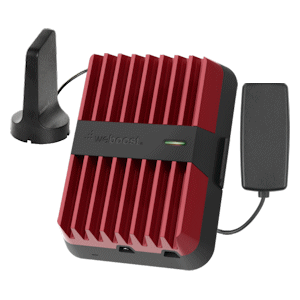Top 4 Mobile Cell Signal Boosters for 2025
Boosters for cars, trucks & RVs

Updated
Need better cellular reception on the road?
Mobile cell signal boosters amplify outside cell signal that’s too weak for your cell phone to pick up and broadcast it inside your car or truck. Some systems also have versions designed for commercial trucks or RVs and fifth wheels. These solutions allow you to make calls, receive text messages, and use apps for navigation, communication, and entertainment.
Powerful Signal has tested the best cell phone boosters from leading manufacturers for cars, trucks, and RVs. Here are our top four recommended systems for this year, sorted by price:




Notes
1 Measured in RSRP. Gain is the increase in the strength of the signal that the booster is able to produce. The higher the maximum gain, the stronger the signal the cellular phone will receive. Gain is measured in decibels (dB), which are logarithmic: An increase of 3 dB doubles the signal strength, an increase of 10 dB is ten times the signal strength, and an increase of 20 dB is one hundred times the signal strength. A booster’s maximum gain varies across the different cellular frequencies it supports; some frequencies will have a higher maximum gain; others, lower.
2 Downlink power is the amount of output power the booster uses to send data to cell phones in its broadcast range; the more downlink power, the more area the booster can cover inside the vehicle. Downlink power is measured in decibel-milliwatts (dBm), which are a logarithmic measurement of milliwatts (mW): 10 dBm is 10 mW of power (one-one hundredth of a watt); 13 dBm is about 20 mW of power (one-fiftieth of a watt), twice that of 10 dBm. The figures in the table above are the booster’s average downlink power across all the cellular frequencies it supports and are drawn from test data submitted to the FCC.
3 Uplink power is the amount of output power the booster uses to send data to a cell tower’s antenna; the more uplink power, the greater the sending range of the booster. Uplink power is measured in decibel-milliwatts (dBm), which are a logarithmic measurement of milliwatts (mW): 20 dBm is 100 mW (one-tenth of a watt); 25 dBm is 316 mW (about one-third of a watt), over three times the power of 20 dBm. The figures in the table above are the booster’s average uplink power across all the cellular frequencies it supports and are drawn from test data submitted to the FCC.
4 Most cell phone signal boosters are carrier agnostic—they amplify signal for all major cellular carriers at the same time.
5 A non-magnetic option (NMO) antenna is permanently mounted in the vehicle’s roof by a professional installer. NMO-mounted antennas are frequently used in fleet vehicles.
6 Cell signal booster systems should use coax cables that match the booster’s impedance. 50-ohm mobile boosters use 50-ohm coax (including LMR‑100 and RG174).
7 Powerful Signal offers a 90-day return on most products. (See our return policy.)

